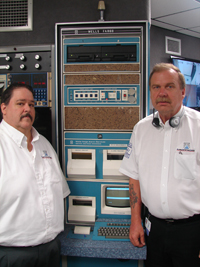
|
| Alarm Detection Systems' assistant central station manager Rick Cahill shuts down what's thought to be the last working Wells Fargo CMP Polling Computer of its kind. PHOTO COURTESY OF ADS |
Alarm Detection Systems of Aurora, Ill. will be retiring its last Wells Fargo CMP Polling Computer — a technology that Bob Bonifas, president and chief executive officer of ADS, believes is the last such working device in the country.
In the 1970s, Wells Fargo’s chief engineer, Tom Lenay, developed the technology that used a circuit provided by the phone company to put 125 customers on a circuit and poll them every 45 seconds to make sure their burglar or fire alarms were still working or had an event. Wells Fargo, later bought out by ADT, was an installation company that sold the $100,000 device to other alarm companies as well. Eventually, after phone companies stopped providing circuits for this technology, ADT stopped supporting the product and alarm companies with the existing devices began phasing them out.
“It was the first real automation system that allowed customers to assign passwords and add users — basically do a lot of the things that operators previously had to handle with phone calls,” Bonifas said. “Even today, there is nothing that really automates quite as well as what this did.”
Because of the cost, customers using the technology were all upper-end commercial clientele, and migration from the Wells Fargo CMP dragged on for years, according to Bonifas. At one point, ADS had 1,200 customers using the technology. One week ago, ADS signed off its last customer, a major bank, and the Aurora, Ill.-based alarm company will send the device to the Central Station Alarm Association in Virginia, where it will be displayed at the Alarm Industry Museum.

|
| Rick Cahill (left), Alarm Detection Systems’ assistant central station manager, and Rick Raper (right), central station manager, stand next to the last Wells Fargo CMP Polling Computer before retiring the technology from its central station on Tuesday, July 12, 2011. PHOTO COURTESY OF ADS |
“Getting the last 100 customers off of it were difficult, because they were thinking of retiring or moving to a new building and didn’t want to spend the money to update their systems; if there was fire attached to it, the code that mandated the addition of horn strobes in buildings made it even more difficult to update,” Bonifas explained.
And so, this week is the end of an era for the alarm industry, which has continued to evolve and replace legacy technologies, such as the Wells Fargo CMP, with the technologies of today. “Someday, 20 years from now, someone will walk into the museum and look at [the Wells Fargo CMP Polling Computer] and say, ‘Wow, what is that?’” Bonifas said.






